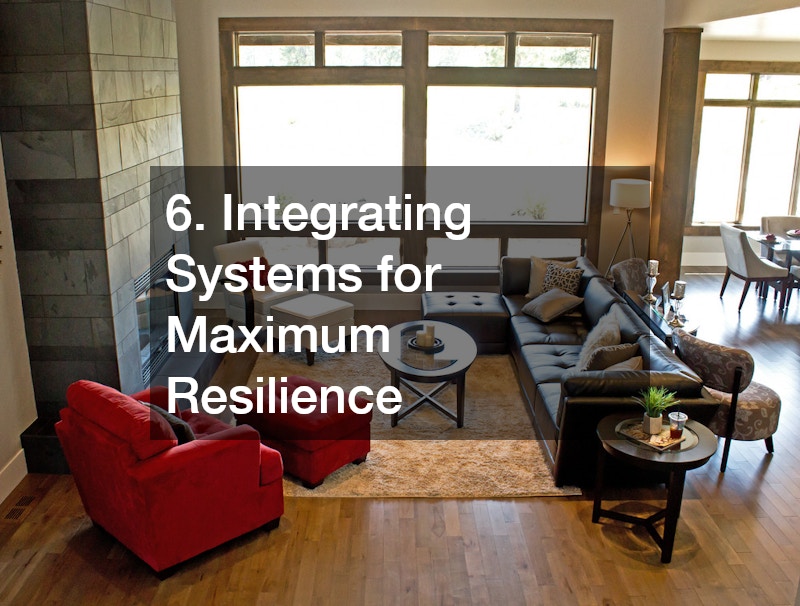A resilient home isn’t just about looks—it’s about peace of mind. When storms roll in, temperatures drop, or pipes act up, your home should be ready to take it all in stride. Whether you live in a coastal area vulnerable to hurricanes or a region that sees its share of heat waves and heavy rain, every homeowner faces challenges that can test the strength of their property.
Resilience starts long before anything goes wrong. It’s in the way your foundation holds steady, your roof defends against weather, your water systems perform, and your air conditioning keeps your family comfortable. When these systems work together, they protect your biggest investment and keep your daily life running smoothly.
This guide dives deep into every major part of your home—foundation, roofing, plumbing, HVAC, and more. You’ll learn practical steps to strengthen your property, avoid major repairs, and keep things running efficiently for years to come. From simple maintenance routines to smart upgrades, these tips will help you make your home stronger, safer, and more comfortable, no matter what life throws at it.
1. Building a Strong Foundation for Long-Term Stability

Your home’s foundation is literally what everything else depends on. A small crack or bit of water intrusion might not look like much now, but over time, it can become a serious problem. Your foundation keeps your structure level, your doors aligned, and your walls crack-free. So, investing time and care here pays off tenfold later.
1.1 Understanding Why Your Foundation Matters
Think of your foundation as the spine of your house—it carries all the weight. When it’s strong, your home stays solid through storms, temperature shifts, and even minor ground movement. But when it’s compromised, other parts of the home start to feel it.
Some telltale signs of foundation issues include:
-
Cracks in walls or ceilings, especially above doors and windows
-
Uneven floors that slope or creak
-
Gaps between exterior bricks or siding
-
Doors and windows that stick or won’t close properly
If any of these sound familiar, it’s time to take action.
1.2 Reinforcing and Protecting Your Home’s Base
When repairs are needed, concrete foundation repair can restore the structure’s stability before things get worse. A professional can assess whether you’re dealing with surface-level cracks or deeper settlement issues. Modern techniques like polyurethane injections or pier systems can lift and stabilize the home while sealing out moisture.
If you live in a flood-prone or coastal area, an elevated home builder can take your protection even further. Elevating your home above flood levels helps protect the entire structure from water damage and can even lower insurance costs. It’s an investment that adds lasting value and peace of mind.
Other foundation-strengthening tips include:
-
Improving drainage around your home by sloping soil away from the base
-
Installing or maintaining gutters to prevent pooling water
-
Using waterproof coatings or membranes to seal the foundation walls
-
Scheduling regular inspections to catch issues early
2. Keeping Your Roof Weather-Ready Year-Round
Your roof takes more punishment than almost any part of your home—sun, wind, rain, and snow all have their say. But with a little care and planning, your roof can last for decades while protecting everything beneath it.
2.1 Regular Roof Maintenance Makes a Big Difference
Small roof problems can turn into big leaks faster than you’d expect. That’s why partnering with a local roofing contractor for regular inspections is one of the smartest things you can do. They’ll know exactly what issues are common in your area—whether it’s hail damage, algae streaks, or worn-out flashing.
Here’s a quick checklist to help keep your roof in good shape:
-
Check for missing, curling, or cracked shingles after major storms.
-
Clean your gutters and downspouts twice a year to avoid water buildup.
-
Inspect attic spaces for damp insulation or light peeking through the roof deck.
-
Trim branches that hang close to your roof to prevent damage.
2.2 Reinforcing Your Home’s Openings Against Wind and Debris
Your doors and windows are just as important to your home’s envelope as the roof itself. If you live in a region with high winds or storm risk, impact door installation is a game-changer. These heavy-duty doors are designed to withstand flying debris and resist break-ins. Plus, they improve insulation and energy efficiency.
Combining durable roofing materials with reinforced doors creates a complete weather barrier. Think of it like giving your home a strong outer shell—it looks great, performs even better, and protects your family during the harshest conditions.
3. Protecting and Maintaining Your Water Supply Systems
A steady, clean water supply is something you never want to take for granted. If your home uses a well, that system is your lifeline—and it needs regular attention to keep things flowing reliably.
3.1 How to Keep Your Well Running Smoothly
Routine well pump service ensures your water stays clear, your pressure remains consistent, and your system operates efficiently. Most experts recommend an annual inspection to check for corrosion, pressure issues, and electrical function.
Here are a few signs your system needs attention:
-
Fluctuating or weak water pressure
-
Dirty or cloudy water
-
Short cycling (the pump turns on and off frequently)
-
Unusual sounds coming from the pump
Regular service can prevent breakdowns, extend the life of your pump, and help you catch small issues before they cause water interruptions.
3.2 What to Do When Things Go Wrong
If your water stops flowing or pressure drops suddenly, you might need well pump repair. Common causes include worn bearings, damaged impellers, or electrical faults. A technician can diagnose whether a repair or full replacement is the best solution.
A few quick maintenance habits can help avoid future problems:
-
Keep the well cap sealed to prevent contamination.
-
Protect the pressure tank from freezing temperatures.
-
Avoid overtaxing the pump by spacing out heavy water use.
-
Install surge protection to guard against electrical damage.
Taking care of your water system means you’ll always have safe, clean water—even when conditions outside aren’t ideal.
4. Plumbing Systems That Withstand Time and Stress

Plumbing is one of those home systems that most people ignore until something goes wrong. But with a little proactive care, you can keep your pipes in top shape and avoid messy surprises.
4.1 Clearing Drains the Right Way
When drains start slowing down, many homeowners reach for harsh chemical cleaners. But these can eat away at pipes and only mask the problem temporarily. That’s where hydro jetting comes in. This professional cleaning method uses high-pressure water to blast away buildup, grease, and even tree roots deep within your pipes.
Benefits of hydro jetting include:
-
Restores full flow capacity to old pipes
-
Prevents recurring clogs
-
Reduces odors and bacteria buildup
-
Extends the life of your plumbing
It’s one of the most effective and environmentally friendly ways to maintain your plumbing system.
4.2 Finding Leaks Before They Turn into Disasters
Water leaks are sneaky—they can hide behind walls, under floors, and even inside your foundation. That’s why leak detection is such an essential service. Professionals use sensors, thermal imaging, and acoustic tools to locate moisture problems before they cause serious structural damage.
Signs you might have a hidden leak:
-
Unexpectedly high water bills
-
Musty smells or mold growth
-
Warm spots on floors
-
Stains on ceilings or walls
Catching leaks early prevents damage to drywall, flooring, and your foundation—and saves you from expensive repairs later on.
5. Ensuring HVAC Systems Operate Efficiently and Reliably
Comfort and air quality play a huge role in your home’s resilience, especially when it comes to extreme weather. A well-maintained heating and cooling system keeps your family comfortable year-round and prevents system failures when you need it most.
5.1 Tune-Ups That Keep You Cool and Comfortable
An annual ac repair or tune-up might not sound urgent—until the middle of summer when your system quits. Regular maintenance helps your AC run efficiently, saving you money on energy bills while extending the system’s life.
Here’s what should be on your AC maintenance checklist:
-
Replace filters every 1–3 months.
-
Clean condenser coils and evaporator fins.
-
Check for refrigerant leaks and thermostat calibration.
-
Inspect ductwork for gaps and insulation issues.
Keeping up with small maintenance tasks ensures your cooling system performs its best, even during the hottest months.
5.2 Supporting Systems That Keep Everything Running
Behind your plumbing and HVAC systems are smaller parts that do big jobs—like pumps. From circulation pumps in your HVAC to sump or condensate pumps, these unsung heroes keep things flowing. Regular pump repairs can prevent leaks, ensure proper drainage, and stop water damage before it starts.
A few quick tips to extend the life of your home’s pumps:
-
Test them seasonally (especially before heavy rain).
-
Keep the area around them clean and clear.
-
Listen for unusual noises, which may signal wear or clogging.
-
Replace failing parts promptly to avoid chain-reaction damage.
When pumps, AC units, and ductwork all run smoothly, your home stays comfortable and safe no matter what the forecast looks like.
6. Integrating Systems for Maximum Resilience

Every system in your home—roofing, plumbing, HVAC, and foundation—is connected. When one fails, the others can feel the strain. Understanding how these systems interact helps you stay ahead of problems and plan maintenance efficiently.
6.1 How One System Affects the Others
Here’s a simple example:
A leaky roof can lead to moisture in your attic, which can damage insulation, affect air quality, and overwork your HVAC system. Meanwhile, poor drainage near your foundation can increase humidity, encouraging mold and compromising structural integrity.
Everything is connected. That’s why a “whole-home” maintenance mindset is so valuable. It’s not just about fixing things—it’s about keeping your home’s systems balanced.
6.2 Building a Preventive Maintenance Schedule
A strong home starts with a solid plan. Create a year-round schedule that prioritizes regular upkeep:
Spring:
-
Inspect roof and gutters.
-
Check for foundation cracks.
-
Schedule HVAC tune-up before summer.
Summer:
-
Clean and test sump or circulation pumps.
-
Check for leaks around windows and doors.
-
Flush drains or consider hydro jetting.
Fall:
-
Inspect roofing and exterior before winter storms.
-
Seal any cracks in driveways or foundation walls.
-
Service your heating system.
Winter:
-
Monitor indoor humidity to prevent condensation.
-
Watch for frozen pipes.
-
Test smoke and carbon monoxide detectors.
This approach helps you stay one step ahead, avoiding emergencies and saving money over time.
7. Smart Upgrades for Long-Term Protection

Once you’ve covered the basics, it’s worth looking at smart upgrades that can make your home even more resilient and efficient. Think of these as long-term investments in comfort and security.
7.1 Choosing Resilient Materials and Systems
If you’re building or renovating, pick materials designed to last. Go for metal or architectural shingles, storm-rated windows, and reinforced framing. Inside, consider energy-efficient HVAC systems, water-saving fixtures, and durable flooring that resists moisture.
7.2 Balancing Cost, Comfort, and Durability
It’s easy to feel overwhelmed by all the possible improvements—but you don’t have to do everything at once. Start with the areas that bring the biggest impact.
A simple approach:
-
Address safety first. Fix foundation cracks, roof leaks, or faulty electrical systems.
-
Upgrade efficiency. Tune your HVAC, seal your home, and upgrade insulation.
-
Add resilience. Install impact doors, elevate utilities, and improve drainage.
Each improvement builds on the next, turning your home into a safer, stronger, more comfortable space.
A resilient home isn’t built overnight—it’s created through consistent care and thoughtful upgrades. By strengthening your foundation, maintaining your roof, keeping water and air systems in top shape, and staying proactive about repairs, you can protect your home against whatever challenges come your way.
Think of resilience as more than just durability. It’s about peace of mind, knowing your home can handle storms, temperature swings, and wear over time. Every small step you take—from fixing leaks early to investing in stronger materials—adds up to a lasting difference.
Start today with one improvement. Schedule that inspection, fix that small issue, or plan your next upgrade. The stronger your home becomes, the safer, more efficient, and more comfortable your life will be.



